The 2012 MacBook Air (11 & 13-inch) Review
by Anand Lal Shimpi on July 16, 2012 12:53 PM EST- Posted in
- Apple
- Mac
- MacBook Air
- Laptops
- Notebooks
Performance
The Ivy Bridge equipped MacBook Airs are definitely faster than their predecessors. But if you're like many and are upgrading from a 2010 or earlier MacBook Air, the difference is astounding.
The improvements don't come exclusively from the faster CPUs, but also from the significantly faster storage. For the first time since it started using SSDs, Apple is at the forefront of solid state storage and the impact on performance shows.

The new Air boasts faster boot time than even the rMBP, I can only assume due to a simpler hardware configuration that allows for faster initialization.
There's a minimal performance difference between the 1.7GHz and 1.8GHz CPUs, but the upgraded 2.0GHz part offers a tangible increase in performance - especially in our CPU bound video transcoding tests. The upgrade is worthwhile if you're a power user trying to make an Air work rather than taking the portability penalty and going with a Pro.

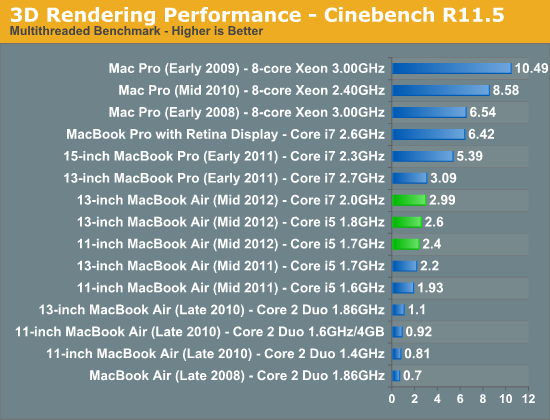
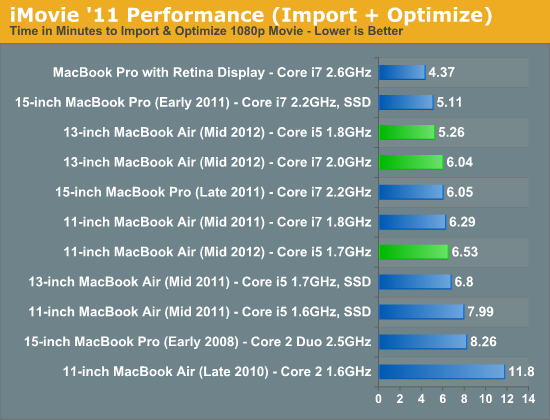
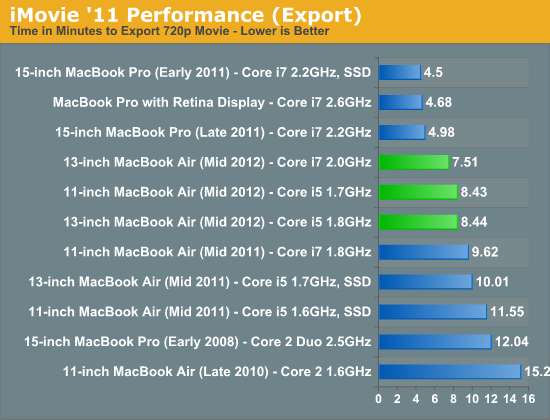
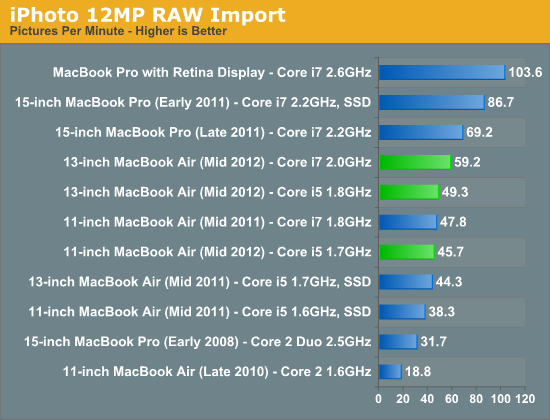
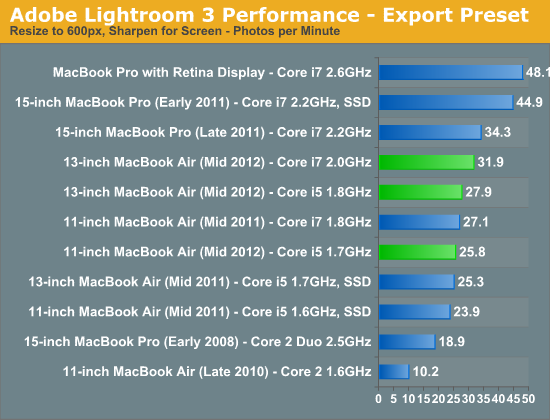
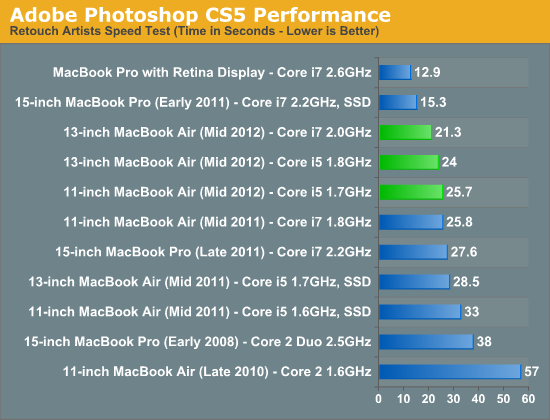

The MBA as a Desktop
With Ivy Bridge, using the MacBook Air as a desktop replacement is surprisingly possible. UI performance on an external Thunderbolt Display at 2560 x 1440 is indiscernible from the rMBP with only a few windows open. It's when you start opening a ton of applications and browser tabs that UI frame rates slow down appreciably. I clocked scrolling down an AT review at 30 frames per second, and activating Exposé with 17 windows open rendered at 18 - 20 fps.
Application responsiveness is quite good thanks to the incredibly quick SSD. With last year's MacBook Air it was possible to have one of these machines serve as your older MacBook Pro replacement. The improvement in storage performance and 8GB memory offering really seal the deal for this year's model. There's still an advantage to going Pro as you've seen in the performance tests thus far, but if you don't do a ton of heavily threaded CPU work (e.g. video/photo editing, 3D rendering) then the Air really can cut it as a primary system.










190 Comments
View All Comments
pmhparis - Wednesday, July 18, 2012 - link
What software is heavily crippled on Macs? Other than CAM/CAD which is very specialized, needs specific harware & is only used by a tiny minority, I cannot think of any.Either be specific or admit that you're full of FUD.
Tegeril - Monday, July 16, 2012 - link
I've seen a lot of discussion on the AT forums and elsewhere, trying to tangibly represent the changes in GPU performance over a number of generations of Mac laptops and desktops, but specifically what you really get out of Intel's new graphics versus the older Nvidia solutions.I'd love to see some kind of reporting on the relative performance of things like:
Intel 2000
Intel 3000
Intel 4000
Nvidia 9400m
Nvidia 320m
----
Nvidia 330m/gt/whatever it was
AMD 6630M
Basically to see how Intel's graphics stack up against the systems that many people are currently using and upon which they are contemplating an upgrade. Perhaps it will be best times for a Haswell comparison so you can throw in Intel 5000 or whatever they decide to call it. But I do think people would find it valuable when considering something like:
"I have this first gen Core i7 CPU MacBook Pro with a 330m/gt in it, if I don't want a retina MBP, my only graphics option without spending $1800 is Intel 4000, how does that stand up to what I'm using now" etc etc.
Anyway, great review as usual, if i weren't already an rMBP owner, I'd be gunning for a 13" MBA.
tipoo - Monday, July 16, 2012 - link
I agree, they should be added to Benchhttp://www.anandtech.com/bench/GPU12/372
Tegeril - Monday, July 16, 2012 - link
I can attest to frequent GPU issues, display corruption, other nonsense with my AMD equipped (6970M) iMac.I'd much rather they keep diversity between manufacturers in their product lines (even if it is generation to generation), but the drivers are kinda crap.
Death666Angel - Monday, July 16, 2012 - link
If I remember correctly, IGZO will be able to reduce the amount of backlight that is caught in the panel. So a higher resolution panel would not necessarily mean increasing the backlight to get the same brightness. :-)TEAMSWITCHER - Monday, July 16, 2012 - link
When I was in college my computer traveled back and forth with me in multiple large boxes. These new MacBook Airs (and the PC Ultra-books) are dream machines for college bound young people, vastly more powerful than the machines I used back in the day. As a Computer Science major having such a device constantly at my fingertips would have been truly life changing! So...Use them for good, and not evil.wditters - Monday, July 16, 2012 - link
Hi Anand, are you sure about the Samsung color profile that your put up for download? It seems awfully off and washed out ... Cheers.billgerr - Monday, July 16, 2012 - link
May get high-end 11-inch MBA as replacement when E4300 bites the dust. I like the E4300, but to this day have not owned a successor to Digital Equipment Co. (can't use term DEC anymore, as few recognize brand) Hi-Note Ultra. IMHO one of the sweetest designs ever, even with its blazingly fast 486DX CPU and floppy-disc wedge.Osamede - Monday, July 16, 2012 - link
This article claims:"....Ultraportables prior to the MacBook Air's arrival in 2008 typically sacrificed in one or more of the above areas......"
Wrong, wrong, wrong. There was the Panasonic Y series Toughbook, as well as the Soy SZ and Z. All of which far outperformed the MacBook Air. I had the Y5 with 14" screen 1400x1050 resolution, 8 hours useful life and it was 3.5 lbs WITH a DVD drive. The Sony Z11 and 12 for example pack power that even the most recent Macbook Air released NOW in 2012 still cannot match - and they also had 13" 1920x1080 screen and a "low end" model with 13" 1600x900 screen.
The way Apple fans are trying to re-write history is scary.
KPOM - Monday, July 16, 2012 - link
What part of "typically" you understand? That doesn't mean that there weren't ANY notebooks, just that they weren't typical of the class.Here is the full context:
Despite the recent Ultrabook frenzy, the MacBook Air was one of the first (if not the first) to marry performance with usability, screen size/resolution, portability and battery life. Ultraportables prior to the MacBook Air's arrival in 2008 typically sacrificed in one or more of the above areas.
The Panasonic Toughbook was 1.9" thick. That fails the portability test:
http://www.cnet.com/4505-3121_7-32309222.html
The Vaio Z series fits the bill, but is significantly more expensive than the MacBook Air. Ultraportables have been around for years, but mostly they had small screens, were thick, had bad keyboards. Heck, even Apple had the Powerbook Duo in the early 1990s.
The Air in 2010 was the first successful attempt to make the ultraportable mainstream. In 2008, it did offer a full size screen and keyboard, and was extremely thin, though it was still pricey.
The way some anti-Apple people are trying to re-write history is scary.